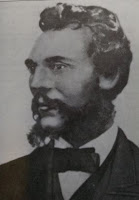Lilly was a pharmaceutical giant.
His relationship to the history of Fairfield, the state, the country and the world ... difficult to measure. The Lilly pharmaceutical business is one of the most intriguing in all the world. Most "big pharma" is like that.
Lilly can be mentioned in the same conversation with Henry Ford, Andrew Carnegie and, probably if Lilly were alive today, Bill Gates or Steven Jobs. When Lilly spoke, people listened. When he acted, people's lives were changed.
 |
| Lilly around 1900 |
James H. Madison, Indiana University history professor and author who specializes in Hoosier life, wrote the Lilly biography in 1989, and the story is mesmerizing.
In 1930, Lilly and his associates developed an efficient process for the mass-manufacture of insulin, calling it in some of their advertising "An Epoch in the History of Medicine. A Boon to the Human Race." (Insulin had been "invented" about 10 years earlier in Canada.)
The Lilly name was instantly set aside as something slightly different from the average run-of-the-mill soothing salve salesman.
The Lilly family had begun their march to the top in the industry a decade or so before that time and, as Madison writes:
"The American pharmaceutical industry changed rapidly in the late 1910s and 1920s. World War I increased the demand for pharmaceuticals and cut off supplies of German drugs and chemicals, forcing American companies to speed up development of their own capabilities in production, research and development."
It stood to reason that the winners in that race would be those that could attract top people, invest money wisely and efficiently and produce medicines that could be afforded, dispensed and ... worked.
Lilly's father, Eli Sr., who had begun working with pharmaceuticals years earlier and was running the Indianapolis company when the war broke out, told his sons Eli Jr. and Joseph to ramp up production of a typhoid vaccine, according to Madison's biography. Old Eli Sr. realized he needed to produce something of value.
"Damnable Barbaric Germany" had come face-to-face with Eli Lilly and was about to lose.
Lilly found financial support from abroad as well when the supplies were reaching the front. Later, Joe Lilly enlisted and became a medical officer in the European theater.
But the stress of wartime production of medicines evidently taught the Lillys some lessons. After the conflict ended, they focused on refining production of their various products.
Insulin emerged and gave the company plenty of financial leverage.
By then, Eli Jr. had taken control of the company from his father.
Lilly was seemingly at the forefront for every crisis that the nation faced. When World War II broke out, it was the Lilly family which developed a useful blood plasma and a large-scale amount of penicillin. Lilly refused to profit from blood plasma production. "By war's end, the firm had dried over 2 million pints of blood, about 20 percent of the United States total," Madison reveals.
Inevitably, it was Lilly's attachment to efficiency in production that emerged as his strongest suit and established his company as one of the most influential of the 20th century, outside of the automobile industry.
After World War II ended, America began to find new ways of healing itself. The home remedy culture faded fast when the marketing of prescription medicine took root. Health insurance emerged as did the consumer's ability to "fix what ailed 'em" in a bottle.
Foreign markets emerged in the 1950s.
What remains fascinating about Lilly, who died in 1977, is his interest in philanthropy outside the business world. He invested vast sums of money in archaeology, historical preservation and the arts. He gave away millions of dollars through his endowment. His family home remains open to the public near the Indianapolis Museum of Modern Art (near Crown Cemetery).
Madison writes an intriguing story about Lilly, who showed a unique appreciation for the history of Indiana.
HISTORY OF INSULIN
CONNER PRAIRIE -- A LILLY PROJECT (Wikipedia)
WAWASEE -- A LILLY PROJECT
















